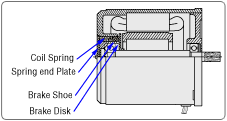Do Different Motors Have Different Overruns?


-

Ms. Ori. I know it's a really basic thing, but there's something I don't understand about the motor's "overrun"...
-

What is it?
-

When stopping a motor, the amount of rotation from the time the power is turned off until the motor comes to a complete stop is called "overrun," right?
-

That's right. The larger the load inertia on the motor shaft, the larger the overrun will be.
-

What? So the load inertia plays a part as well?
-

That's right. For example, a truck with a cargo and a truck without a cargo. If both trucks made a sudden stop at the same speed, the truck with the cargo will have a larger distance from the required stop. In the same way, the larger the motor's load inertia, the larger the overrun will be.

-

I see! How much overrun does a motor usually have?
-

That differs depending on the motor's product line. The overrun of an induction motor is about 30 to 40 revolutions with no load inertia.
-

So different motors have different overruns?!
-

That's right. In the case of a reversible motor, it would be about 5 to 6 revolutions.
-

What? Why does a reversible motor have a smaller overrun than an induction motor?
-

The reversible motor has a built-in friction brake that allows you to instantly switch the rotation direction. That's why the overrun is smaller compared to an induction motor.
-

I see. By the way, what kind of brake is a "friction brake"?
-

It has a brake disk attached to the rotor, with the brake shoe pressed up against it.

-

I see. This overrun is the number of rotations of the motor shaft!
What happens to the overrun when using a gearhead then? -

Good point! Yes, it represents the number of rotations of the motor shaft. Therefore, the overrun of the output shaft when using the motor with a gearhead will be "1/gear ratio" of the gearhead.
-

That means, for example, if you were using a gearhead with a gear ratio of 1:3 for an induction motor, the overrun of the gearhead output shaft would be about 10 to 13 revolutions, right?
-

That's right. The larger the gearhead gear ratio, the smaller the overrun will be. However, since the rotation speed is also reduced to 1/gear ratio, the operating speed would become slower. In other words, productivity would drop. We need to make sure that our customers are fully aware of this.
If you want to reduce just the overrun without changing the rotation speed, you can use an electromagnetic brake motor, or use a brake pack. -

Ah! I just learned the other day.
You have an electromagnetic brake motor that holds it mechanically, and a brake pack that applies a braking current to perform an instantaneous stop. -

That's right. The overrun for an electromagnetic brake motor would be about 2 to 3 revolutions, and for a brake pack it would be about 1 to 1.5 revolutions.
-

OK. Even if you look at overrun as a point of reference, it varies so much depending on the motor.
List of overruns by motor product line (reference values)
| Induction Motor |
Reversible Motor |
Electromagnetic Brake Motor |
Brake Pack Used Together |
|
|---|---|---|---|---|
| No Load Motor Only |
Approx. 30~40 rotation |
Approx. 5~6 rotation |
Approx. 2~3 rotation |
Approx. 1~1.5 rotation |
| With 1:3 Gear Ratio Gearhead Installed |
Approx. 10~13 rotation |
Approx. 1.7~2 rotation |
Approx. 0.7~1 rotation |
Approx. 0.3~0.5 rotation |
-

You need to use different motors for different applications. So when you get an inquiry from a customer, make sure to check the operating conditions and introduce the appropriate motor!
-

Yes! I'll do my best. Thank you very much.
